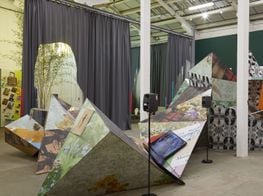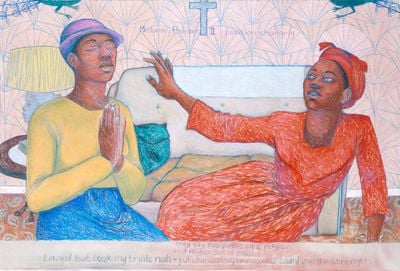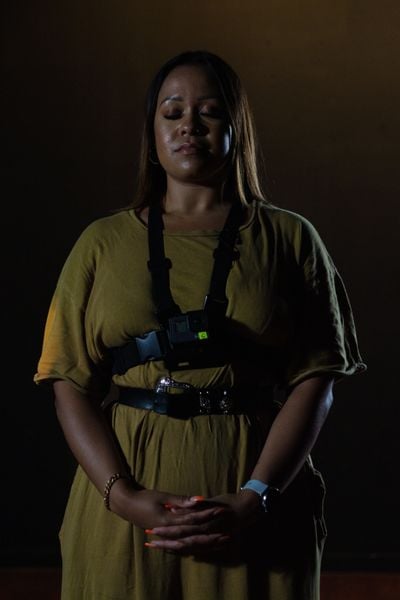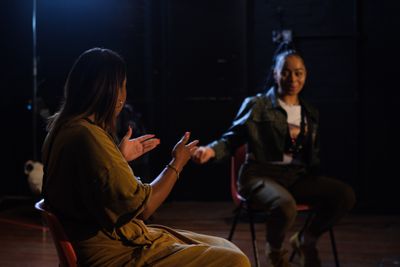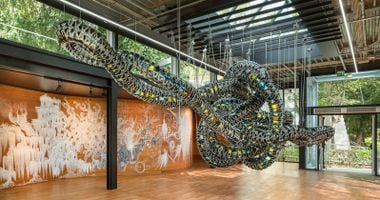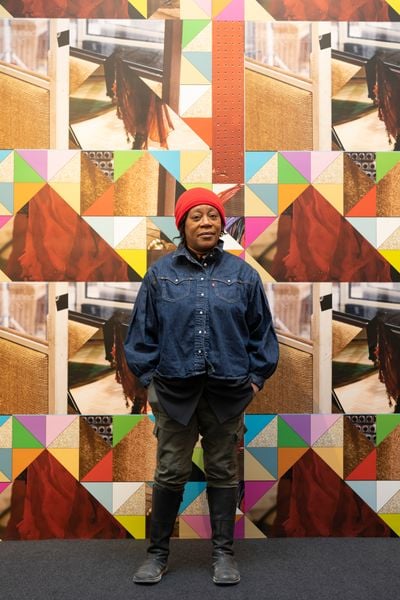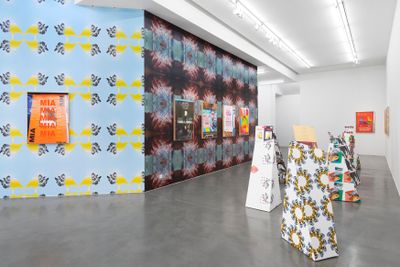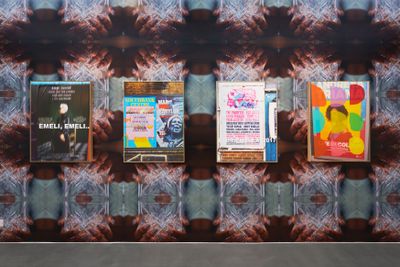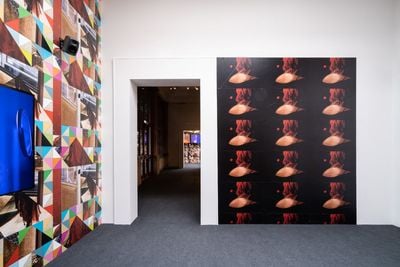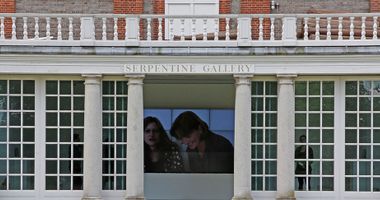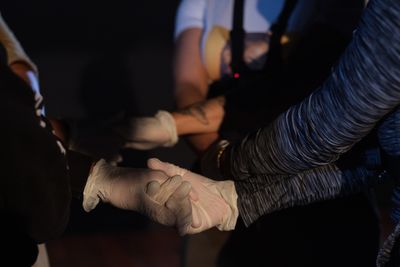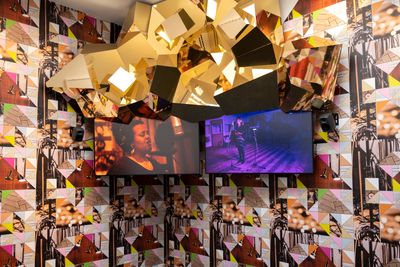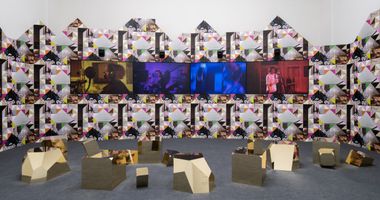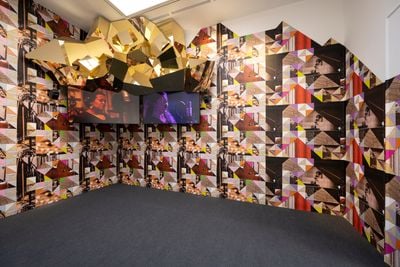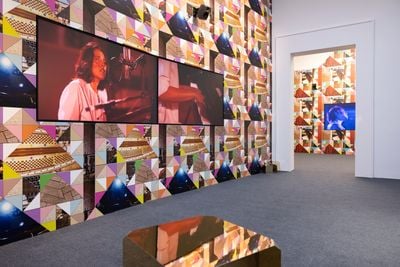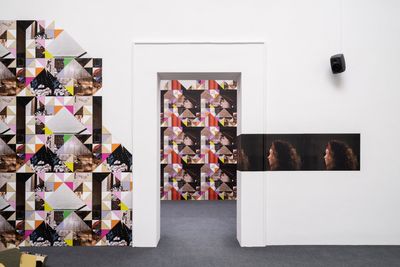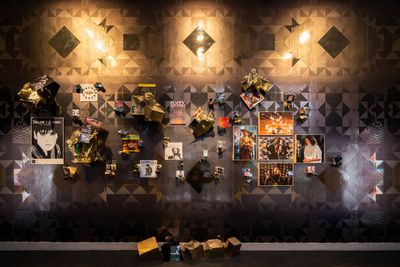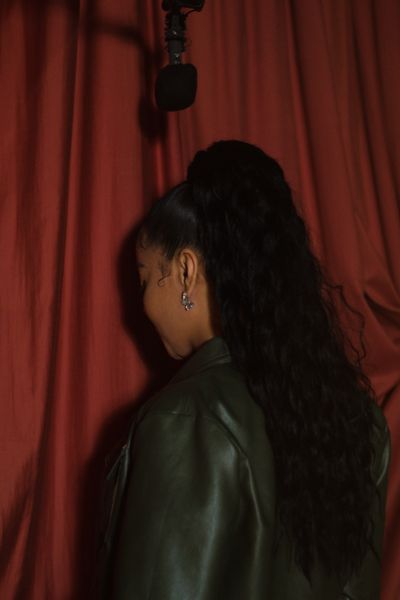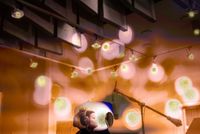Sonia Boyce: 'The Afterlife of Projects Remains a Question'
Sonia Boyce. Courtesy the artist and Simon Lee Gallery, London/Hong Kong. Photo: Parisa Taghizadeh.
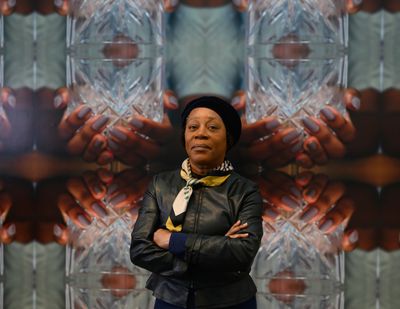
Sonia Boyce. Courtesy the artist and Simon Lee Gallery, London/Hong Kong. Photo: Parisa Taghizadeh.
Sonia Boyce represented Britain at the 59th Venice Biennale in 2022, winning the Golden Lion for her community-based approach. But, she asks, what happens after her projects end?
Boyce was a key member of the British Black Arts Movement, a radical political art movement formed in the early 1980s that examined issues around race, gender, and the legacies of colonialism. Associated artists and curators included Eddie Chambers, Lubaina Himid, Keith Piper, and Donald Rodney.
Boyce's early mixed media works tackled race and gender in daily life alongside references to the British Afro-Caribbean diaspora. Her large-scale drawing Missionary Position II (1985) was acquired by the Tate in 1987, making her one of the youngest artists of her generation to have her artwork acquired by the institution and the first Black British female artist to enter their collection.
Boyce's approach took a turn in the 1990s, with community collaborations coming to the fore. This is evident in her ever-growing 'Devotional' archive project which began in 1999 as a part of a workshop in Liverpool. Boyce invited a group of women to sing and reflect on the first record they ever bought.
At the end of the session, participants were asked to name a Black British female singer. The series has led to a growing list, recognising singers and artists like Sade, Floetry, Ms Dynamite, Poly Styrene, and Joan Armatrading.
At the core of Boyce's projects is the concept of community—recognising the energy, labour, and relationships that bind us together. This is apparent in her deeply moving project, Yes, I Hear You (2021), the culmination of two years of research which was presented at the Serpentine and at Barking Town Hall and Learning Centre (both 2022).
Centred on giving voice and visibility to those who had experienced domestic abuse, Yes, I Hear You created a space for deep listening, sharing, and reckoning in a four-channel video installation accompanied by prints and wallpapers.
In 2016, Boyce was the first Black woman to be elected to the Royal Academy of Arts in London. She was made an Officer of the Order of the British Empire in 2019 for services to art.
For the British Pavilion at the 59th Venice Biennale in 2022, Boyce presented Feeling Her Way, where it was awarded the Golden Lion for Best National Participation. The commission, which is now showing at Turner Contemporary in Margate and later touring to Leeds Art Gallery, explored collaborative play's potential to lay paths for innovation.
Featuring musicians Poppy Ajudha, Jacqui Dankworth, Sofia Jernberg, and Tanita Tikaram, who were invited to improvise, interact, and play with their voices under the guidance of composer Errollyn Wallen, Feeling Her Way furthered Boyce's intent with her 'Devotional' project, collecting a history of female Black British singers and addressing the lack of an expansive archive of Black musical history in the U.K.1
Boyce speaks on her beginnings in art, transformational moments and her move towards improvised and community-centred projects, reflecting on the afterlife and legacy of projects.
JDYou began your career producing mixed media figurative drawings, and later worked more with wallpapers and wall-based installations like in your 'Devotional' series (1999–). Could you speak about your relationship to architecture and how you use wallpaper and vinyl to transform spaces?
SBI've always used wallpaper in my artworks. When I was 15, I was encouraged by my teacher to go to the local art school. I began attending life drawing sessions one day a week and my tutor, Arthur, would tell me off for not placing figures within a context—by that he meant a background or a setting.
I had quite an academic training in my early years, but the more I developed my drawing, especially during my BA, I began to think back to my earlier life drawing classes and the feedback from Arthur to introduce a background to the work.
One solution was to go to the library and look up the history of British wallpaper. At the time, I was trying to articulate my experience of growing up in an Afro-Caribbean household, so the domestic space was key. This was how wallpaper entered into the background as a framing device—it solved a problem for me straight away. From then on, wallpapers have come in and out of the works I've created.
I have come to understand that the function of wallpaper is to frame a space. I grew up in the sixties and seventies in a home filled with wallpaper in every room, so I was surrounded by lots of pattern. I have been thinking about how repeat pattern creates a sense of narrative, of storytelling. Wallpaper is there specifically to hold a space for those narratives.
JDDomestic spaces make strong impressions on how we read and experience future spaces—it's useful to think about what they embody in something like wallpaper, and the narratives they project.
SBWhen I was a student, I looked at the work of William Morris who is regarded as the quintessential English designer of wallpaper and patterns. He took the 'wildness' of nature and found a way to appease what may appear to be its disorderliness and brought it indoors. Wallpaper often brings order to the external and internal worlds, in a sense.
JDDrawing was an important part of your early practice, but you moved to working collaboratively particularly for audiovisual and performance works. When I think about my experience of Yes, I Hear You for Radio Ballads at Serpentine, and more recently Feeling Her Way at Venice, I think of negotiations and understandings of freedom. What does freedom mean to you and how does this concept shape your practice?
SBI have been collaborating with others since the 1990s. Talking can be seen as an immaterial activity, however the way we communicate with each other becomes the starting point for how I make artwork. This could begin with people telling me things, or in a conversation that develops over time. That for me is a critical part of the practice because it's a format for negotiating different perspectives.
When I first started to work with other people, I approached it as if I should be directing them. But it became evident that I was less interested in directing others and more invested in letting a dialogue unfold naturally through improvisation.
I deliberately don't direct others, but rather I encourage and support them in the process. People can feel really terrified of this open-ended process—often what I do is completely unscripted. For some people that's terrifying. For others, it's an opening for their own imagination, which is important to me.
There are a couple of things going on. One, the question of agency. Everyone has agency—how do they deal with that? Secondly, I'm interested in what happens when people come together for the first time and how they negotiate this scenario where what they feel is being projected onto them.
Yes, I Hear You is about domestic abuse and the question of care. Conversely, Feeling Her Way is about improvisation and women singing. Both encounters involved people who did not know each other, so it became about how to negotiate our differences when we may have pre-conceptions about who this other person is.
The question about what freedom means relates to the fact that freedom can't happen without other people. It is dependent on our relations and how we might negotiate spaces with each other.
Yes, I Hear You was very difficult in its subject matter and its realisation. Most of the project involved people who work in social care, and survivors of domestic abuse and violence. All the interviews and workshops happened remotely because of the various lockdowns during Covid-19—this isn't the way I would normally conduct the work. I had to create a safe space virtually via Zoom for domestic abuse and violence survivors, as well as perpetrators, for them to be able to speak to me. When we weren't in lockdowns, I was able to meet up in person.
Due to the nature of the subject, not everyone I interviewed was a part of the final film, but they provided a context for performers—who had survived domestic abuse and violence—to convey their stories.
I needed to be acutely aware of what was being asked of participants in these projects as the artwork is shared publicly. It's a delicate line. Working in this way, I hope, releases something for all of us to think about and feel. Something that we can share somehow—either a question about caring or how the voice touches us on a deep emotional level.
JDYou have never shied away from asking difficult questions, whether about the complexities of understanding history, or on a more personal level using your role as an artist to continually unearth and reveal what has been overlooked. What are the challenges you have faced, particularly when working with communities outside of the art world?
SBIt is always a challenge to work with public engagement as social practice. Working with communities and thinking about the afterlife of projects remains a question, because it's not something that necessarily fits into the narrative of the art world. What happens once you leave? What happens to the people that you've left?
I have been thinking about the groups I work with, and what can become an exit strategy. There is a sense that there can suddenly be a spotlight on someone that's to do with a particular issue or way of working that those involved may or may not have done before. But when the spotlight shifts, what kind of legacy is left behind? How are expectations managed both when the spotlight is on, and off?
I don't yet have a response to all of this, but I do feel that as an artist, I'm channelling people's voices that can touch fundamental nerves and ask questions for us all.
I am itinerant in the way that I work, and as I go from one place to another this question about aftermath is increasingly important to me. I don't know necessarily what happens afterwards. My ego would love to think that there is a positive transformation that comes from all of this, but I can't honestly say that's the case.
I need to find a period for going back to reflect, and to see the ways in which there is continuity. This requires a certain type of infrastructure that most arts projects don't have—it is about resources and the capacity to build these into a project from the start. That's something we should all be thinking about—everyone who works in a social practice, whether the institution or the artists—a more holistic way that isn't just about forms of bureaucratic evaluation, now and into the future.
JDWhere do you see institutions going in the future? When something is topical, a lot of momentum builds around certain issues. But in terms of continuing the work, there do need to be some quite radical changes in how the institutions function.
SBWhat I hear in the background of that question is a familiar refrain about the position of Black people in relation to what White institutions are. In the Black Arts Movement in the 1980s, there were a lot of conferences and public discussions about Black people—artists, cultural producers, etc.—and their positions within White institutions.
We need to rethink this question, as it gives the impression of an assumption that institutions are White, and Black people are outside of that institutional structure—as if we are interlopers or trespassers, not fully present or deserving of continuous attention like any other arts practitioners.
The reason why things may seem 'on topic' is because it hides the fact that there are Black people who have persistently been at the forefront of change within the institutional narrative. There's a long trajectory of Black people insisting and working quietly in the background, pushing against narratives of exclusion or an absence of our collective place in history. There are moments when there has been a spotlight. After a while, when that goes, at specific moments the spotlight comes back, and so on.
This is not specifically to do with my work, but there was, for example, a project that happened at the Slade School of Fine Art where researchers were looking at the Bloomsbury group during the 1920s, and the position of Black artists and models within British modernism at that time. We are now just starting to find out about this. There were things happening at the turn of the 19th century and into the 20th. We need to know about this so that we don't feel we are constantly returning as the 'firsts' or momentarily as 'on topic'. —[O]

